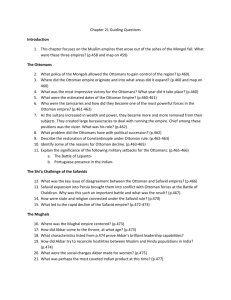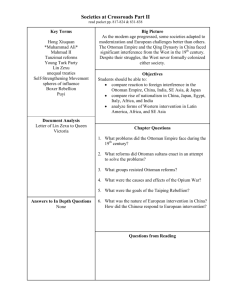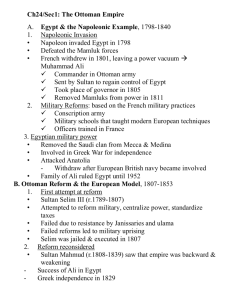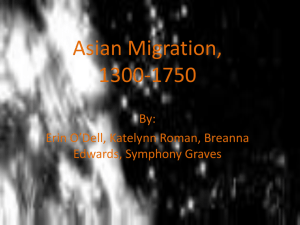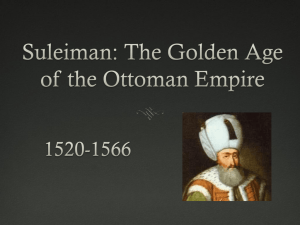Ottoman Empire
advertisement
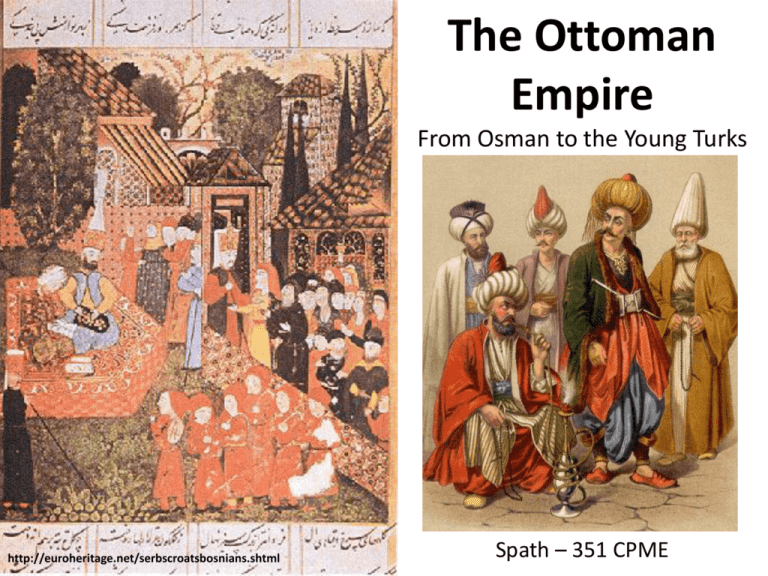
The Ottoman Empire From Osman to the Young Turks http://euroheritage.net/serbscroatsbosnians.shtml Spath – 351 CPME Readings M.E. & Islamic World Reader – • Origins of Islam (excerpts from Qu’ran) • The Caliphate (and schism) • Various early dynasties (esp. Umayyad & Abbasid) • The Ottoman, Safavid, and Mughal Empires (gunpowder empires) In Cleveland – Tanzimat period of the Ottoman Empire (18391876). Today: Ottoman Empire (end of 13th c. – 1922) We will cover up to the turn of the 20th century Big Questions: - What happened? How did the empire change? - Why was the Ottoman Empire so dominant? - Why did it decline? - Why is this important to contemporary ME politics? Where are We Going? - Monday: Colonialism - Tuesday: WWI, Inter-War Years The Gunpowder Empires Ottomans, Safavids, Mughals became dominant after Mongol Empire. Why? - Mongol Legacy -Agrarianism - Trade Revenue - Gunpowder - Governing Strategies The Ottomans: - Started with Osman and his son Orhan - Gazi Tradition - Pragmatic Considerations Ottoman Rule - Gaza (Gazis) tradition of religious expansion - Urbanization of imperial cities - Toleration of local customs - Millet System - Dhimmi - Dynastic Succession & fratricide - Devshirme Levy - Four-level ruling elite The Ottoman Empire Expansion under Mehmed II • Ruled the Ottoman Empire from 1451 to 1481 • In 1453, he toppled the Byzantine Empire, capturing Constantinople, renaming it Istanbul, and making it the new Ottoman capital • Expanded the empire to become the ruler of “two lands” (Europe and Asia) and “two seas” (the Mediterranean and the Black) Scene from the battle defending Constantinople from a 1499 painting Selim I – Selim the Grim • The Sunni Ottomans under Selim the Grim (reigned 1512-1520) detested the Shiite Safavids and launched a full-scale invasion of Safavid territory Battle of Chaldiran • The critical battle in this campaign was the battle of Chaldiran in 1514 • The Ottomans won and temporarily occupied the Safavid capital of Tabriz but could not completely destroy the Safavid state • The Ottomans and Safavids continued to fight intermittingly for the next two centuries Suleyman the Magnificent • Reigned from 1520 to 1566 and continued the expansion • Conquered Baghdad in 1534 • Siege on Vienna (Hapsburgs) • Moved across N. Africa 18th Century: Decline - External Forces - Economy - Military - Loans - Decentralization - Janissaries - Bureaucracy - Ulema - Governors & Notables 19th Century: Towards Consolidation and Re-centralization - Selim III - Muhammad Ali - Mahmud II Selim III and his “New Order” • • • • Attempt at recentralization Devsirme system replaced by Nizam-I Jadid Diplomatic Engagement with Europe Assassination from supporters of Status Quo Mahmud II • Reigned from 1808 to 1839 and launched a reform program designed to restore the traditional Ottoman military • The elite and powerful Janissaries opposed the reforms, but Mahmud massacred them • He remodeled his institutions, especially his military, along European lines – European-style uniforms – European tactics and weaponry – European education Janissaries Muhammad Ali Discussion: Tanzimat and Its Effects • Integration into empire of people on outskirts of the empire • disincentive rising up with nationalist sentiment against empire • Nationality Law – allowed for common citizenship regardless of religion • LEGAL REFORMS • increased autonomy of the millets • civil and political rights • individual court systems • public trials, legal representation, rights of privacy, equal protection • Europeanization of the military • the military academies taught in french • standardized under the state, open to all, increased secular education •Effects • Reforms were incredibly costly they borrowed • Major economic problems and loan default • Nationalism, some of the Muslim population, ulema • split among officials in the Ottoman ruling class (religious and secular) • produced fissure between nobility and masses (peasants) • smaller consolidated territory and governance



